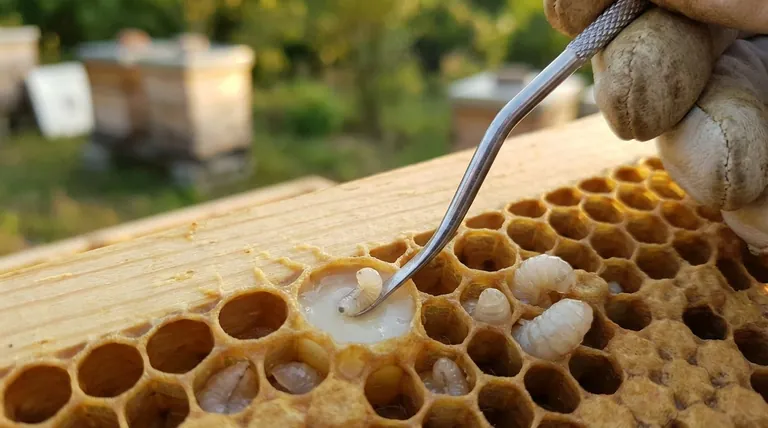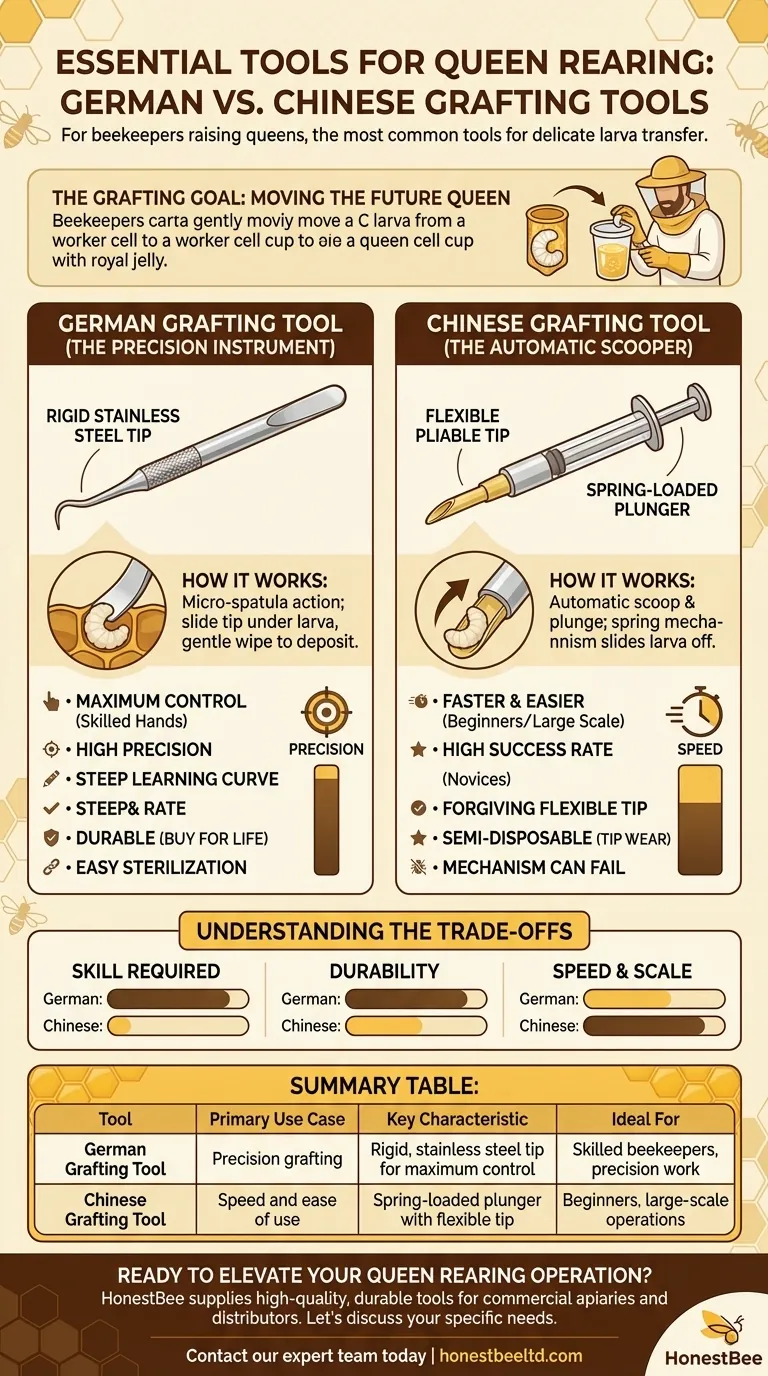For beekeepers raising queen bees, the most common tools used for grafting larvae are the German grafting tool and the Chinese grafting tool. Each is designed for the delicate task of transferring a day-old larva from a worker cell into a prepared queen cell cup, but they operate on fundamentally different principles.
The choice between grafting tools is a classic trade-off between precision and speed. The German tool offers maximum control for skilled hands, while the Chinese tool provides an easier, faster method ideal for beginners and large-scale operations.
The Goal of Grafting
Grafting is the manual process of selecting very young female larvae and moving them into artificial queen cells. This action simulates the natural process of queen rearing, tricking the hive into feeding these larvae a diet of royal jelly to develop them into new queens.
How the Grafting Process Works
The core of the process is the transfer itself. A beekeeper selects a larva of the correct age, typically one that is C-shaped and "floating" on a bed of royal jelly.
The tool is used to gently scoop the larva, along with a small amount of jelly, without damaging it. It is then carefully placed onto the bottom of a plastic or wax queen cup. These cups are then placed into a "cell builder" hive to be raised.
A Closer Look at Common Grafting Tools
While the goal is the same, the two primary tools achieve it in different ways.
The German Grafting Tool (The Precision Instrument)
This tool is typically a single piece of stainless steel with a very fine, flattened, and slightly curved tip. It functions like a micro-spatula.
To use it, you slide the thin tip under the larva and the royal jelly it floats on. Control and visibility are excellent, but it requires a very steady hand. Placing the larva in the queen cup involves a gentle wiping motion to deposit it correctly.
The Chinese Grafting Tool (The Automatic Scooper)
This tool features a thin, pliable plastic or bamboo reed at the tip. A spring-loaded plunger retracts this delicate tip into the tool's body.
To use it, you gently push the tip under the larva. The flexible reed scoops it up. To deposit the larva, you press the plunger, which pushes the reed forward and gently slides the larva off into the queen cup. This mechanism makes both pickup and placement quick and easy.
Understanding the Trade-offs
Neither tool is universally superior; the best one depends on your skill and objective.
Skill vs. Ease of Use
The German tool has a steeper learning curve. Its rigidity means a small mistake can injure the larva. However, once mastered, it offers unparalleled precision.
The Chinese tool is far more forgiving for beginners. The flexible tip and simple deposit mechanism reduce the risk of damaging larvae, leading to higher success rates for novices.
Durability and Maintenance
A stainless steel German tool is a "buy it for life" instrument. It's durable, easy to sterilize, and will not wear out.
The Chinese tool's delicate tip, whether plastic or bamboo, can break or wear over time. They are often considered semi-disposable, though they are inexpensive to replace. The spring mechanism can also eventually fail.
Speed and Scale
For beekeepers who need to graft hundreds of cells in a single session, the speed of the Chinese tool is a significant advantage. The scoop-and-plunge action is faster than the delicate slide-and-wipe motion required by the German tool.
Making the Right Choice for Your Apiary
Your decision should be based on your personal goals and experience level in queen rearing.
- If your primary focus is mastering a skill with maximum precision: Choose the German grafting tool for its superior control and feedback.
- If your primary focus is speed and a higher initial success rate: The Chinese grafting tool is the most efficient and user-friendly option, especially for large numbers of grafts.
- If you are a complete beginner: Start with the Chinese tool to build confidence and technique before considering the more demanding German tool.
Ultimately, the success of your grafts depends more on selecting larvae of the correct age and handling them gently than on the specific tool you choose.

Summary Table:
| Tool | Primary Use Case | Key Characteristic | Ideal For |
|---|---|---|---|
| German Grafting Tool | Precision grafting | Rigid, stainless steel tip for maximum control | Skilled beekeepers, precision work |
| Chinese Grafting Tool | Speed and ease of use | Spring-loaded plunger with flexible tip | Beginners, large-scale operations |
Ready to Elevate Your Queen Rearing Operation?
Choosing the right grafting tool is just the first step. HONESTBEE supplies commercial apiaries and beekeeping equipment distributors with the high-quality, durable tools needed for success. Whether you're grafting dozens of cells or hundreds, we provide the reliable equipment that supports your scale and skill level.
Let's discuss your specific needs. Contact our expert team today to find the perfect grafting tools and supplies for your apiary.
Visual Guide

Related Products
- Stainless Steel Beekeeping Queen Grafting Tool for Honey Bee Rearing
- Black 2 Pack Beekeeper Queen Grafting Tool for Bee Queen Larva Transferring Needle
- Double Head Beekeeping Grafting Tools for Beekeepers
- Plastic Chinese Queen Grafting Tool for Bee Queen Rearing
- HONESTBEE Professional Long Handled Hive Tool with Precision Cutting Blade
People Also Ask
- What is the role of enzymes in honey production? How Bees Transform Nectar into a Superfood
- What are the advantages of metal queen excluders? Invest in Durability & Hygiene for Your Hives
- What are the steps involved in using a queen grafting tool? A Guide to Successful Queen Rearing
- What should be done after grafting is completed? A Step-by-Step Guide to Protect Your Queen Cells
- What is the grafting method for raising queen bees? Master Genetic Control for Your Apiary



















